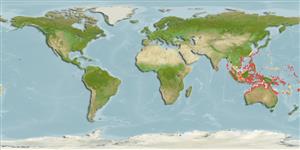Common names from other countries
>
Acanthuriformes (Surgeonfishes) >
Siganidae (Rabbitfishes)
Etymology: Siganus: Latin, siganus = a fish, rabbit fish; by the similarity of the nose (Ref. 45335).
More on authors: Fowler & Bean.
Environment: milieu / climate zone / depth range / distribution range
Ecologia
marino associati a barriera corallina; distribuzione batimetrica 12 - 30 m (Ref. 9710). Tropical; 30°N - 24°S
Western Pacific: southern Ryukyu Islands, Palau (Belau), Philippines, northern Indonesia, Papua New Guinea, northern Queensland and reefs off northwestern Western Australia.
Size / Peso / Age
Maturity: Lm ? range ? - ? cm
Max length : 35.0 cm SL maschio/sesso non determinato; (Ref. 48637); common length : 25.0 cm TL maschio/sesso non determinato; (Ref. 9813)
Spine dorsali (totale) : 13; Raggi dorsali molli (totale) : 10; Spine anali: 7; Raggi anali molli: 9; Vertebre: 13. Head and body dark chocolate brown with purplish hue; iris pale rose-brown, white spotted. Spines stout, pungent, venomous. Preopercular angle 93°-109°. Cheeks completely scaled. Midline of thorax scaled; a row of scales absent along pelvic ridges. Anterior nostril with low rim; expanded posteriorly into a broad flap, reaching halfway to posterior nostril.
Inhabits lagoon and channel reefs (Ref. 9710), usually near steep slopes and harbours (Ref. 48637). Usually seen in pairs. Feeds on benthic seaweeds (Ref. 9813).
Life cycle and mating behavior
Maturities | Riproduzione | Spawnings | Egg(s) | Fecundities | Larve
Woodland, D.J., 1990. Revision of the fish family Siganidae with descriptions of two new species and comments on distribution and biology. Indo-Pac. Fish. (19):136 p. (Ref. 1419)
IUCN Red List Status (Ref. 130435)
CITES (Ref. 128078)
Not Evaluated
Threat to humans
Harmless
Human uses
Pesca: scarso interesse commerciale
Strumenti
Special reports
Download XML
Fonti Internet
Estimates based on models
Preferred temperature (Ref.
115969): 25.2 - 28.9, mean 27.7 (based on 166 cells).
Phylogenetic diversity index (Ref.
82804): PD
50 = 0.5000 [Uniqueness, from 0.5 = low to 2.0 = high].
Bayesian length-weight: a=0.01445 (0.00650 - 0.03213), b=3.08 (2.90 - 3.26), in cm Total Length, based on LWR estimates for this Genus-body shape (Ref.
93245).
Trophic level (Ref.
69278): 2.0 ±0.00 se; based on food items.
Resilienza (Ref.
120179): Alto, tempo minimo di raddoppiamento della popolazione meno di 15 mesi (Preliminary K or Fecundity.).
Fishing Vulnerability (Ref.
59153): Low to moderate vulnerability (33 of 100).
